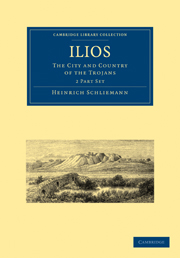Book contents
- Frontmatter
- Contents
- MAPS AND PLANS
- DIAGRAM
- COMPARATIVE TABLE OF FRENCH AND ENGLISH MEASURES, EXACT AND APPROXIMATE
- PREFACE
- INTRODUCTION.—AUTOBIOGRAPHY OF THE AUTHOR, AND NARRATIVE OF HIS WORK AT TROY
- CHAPTER I THE COUNTRY OF THE TROJANS (οἱ Τρῶες)
- CHAPTER II ETHNOGRAPHY OF THE TROJANS: THEIR SEVERAL DOMINIONS IN THE TROAD: TOPOGRAPHY OF TROY
- CHAPTER III THE HISTORY OF TROY
- CHAPTER IV THE TRUE SITE OF HOMER'S ILIUM
- CHAPTER V THE FIRST PRE-HISTORIC CITY ON THE HILL OF HISSARLIK
- CHAPTER VI THE SECOND PRE-HISTORIC CITY ON THE SITE OF TROY
- CHAPTER VII THE THIRD, THE BURNT CITY, Page 305 to 357
- THE THIRD, THE BURNT CITY, Page 358 to 413
- THE THIRD, THE BURNT CITY, Page 414 to 465
- THE THIRD, THE BURNT CITY, Page 466 to 517
- CHAPTER VIII THE FOURTH PRE-HISTORIC CITY ON THE SITE OF TROY
- CHAPTER IX THE FIFTH PRE-HISTORIC CITY OF TROY
- CHAPTER X THE SIXTH CITY, MOST PROBABLY A LYDIAN SETTLEMENT
- CHAPTER XI THE SEVENTH CITY: THE GREEK ILIUM; OR NOVUM ILIUM
- CHAPTER XII THE CONICAL MOUNDS IN THE TROAD CALLED THE HEROIC TUMULI
- APPENDIX I TROY AND HISSARLIK
- APPENDIX II ON THE RELATION OF NOVUM ILIUM TO THE ILIOS OF HOMER
- APPENDIX III THE INSCRIPTIONS FOUND AT HISSARLIK
- APPENDIX IV THYMBRA, HANAÏ TEPEH
- APPENDIX V MEDICAL PRACTICE IN THE TROAD IN 1869
- APPENDIX VI CATALOGUE OF THE PLANTS HITHERTO KNOWN OF THE TROAD, COMPILED ACCORDING TO THE COLLECTIONS OF PROFESSOR RUDOLF VIRCHOW AND DR. JULIUS SCHMIDT, AND FROM THE LITERARY SOURCES BY PROFESSOR PAUL ASCHERSON OF BERLIN, PROFESSOR THEODOR VON HELDREICH OF ATHENS, AND DOCTOR F. KURTZ OF BERLIN
- APPENDIX VII ON THE LOST ART OF HARDENING COPPER
- APPENDIX VIII ON HERA BOÖPIS
- APPENDIX IX TROY AND EGYPT
- INDEX
- Plate section
CHAPTER IV - THE TRUE SITE OF HOMER'S ILIUM
Published online by Cambridge University Press: 05 August 2011
- Frontmatter
- Contents
- MAPS AND PLANS
- DIAGRAM
- COMPARATIVE TABLE OF FRENCH AND ENGLISH MEASURES, EXACT AND APPROXIMATE
- PREFACE
- INTRODUCTION.—AUTOBIOGRAPHY OF THE AUTHOR, AND NARRATIVE OF HIS WORK AT TROY
- CHAPTER I THE COUNTRY OF THE TROJANS (οἱ Τρῶες)
- CHAPTER II ETHNOGRAPHY OF THE TROJANS: THEIR SEVERAL DOMINIONS IN THE TROAD: TOPOGRAPHY OF TROY
- CHAPTER III THE HISTORY OF TROY
- CHAPTER IV THE TRUE SITE OF HOMER'S ILIUM
- CHAPTER V THE FIRST PRE-HISTORIC CITY ON THE HILL OF HISSARLIK
- CHAPTER VI THE SECOND PRE-HISTORIC CITY ON THE SITE OF TROY
- CHAPTER VII THE THIRD, THE BURNT CITY, Page 305 to 357
- THE THIRD, THE BURNT CITY, Page 358 to 413
- THE THIRD, THE BURNT CITY, Page 414 to 465
- THE THIRD, THE BURNT CITY, Page 466 to 517
- CHAPTER VIII THE FOURTH PRE-HISTORIC CITY ON THE SITE OF TROY
- CHAPTER IX THE FIFTH PRE-HISTORIC CITY OF TROY
- CHAPTER X THE SIXTH CITY, MOST PROBABLY A LYDIAN SETTLEMENT
- CHAPTER XI THE SEVENTH CITY: THE GREEK ILIUM; OR NOVUM ILIUM
- CHAPTER XII THE CONICAL MOUNDS IN THE TROAD CALLED THE HEROIC TUMULI
- APPENDIX I TROY AND HISSARLIK
- APPENDIX II ON THE RELATION OF NOVUM ILIUM TO THE ILIOS OF HOMER
- APPENDIX III THE INSCRIPTIONS FOUND AT HISSARLIK
- APPENDIX IV THYMBRA, HANAÏ TEPEH
- APPENDIX V MEDICAL PRACTICE IN THE TROAD IN 1869
- APPENDIX VI CATALOGUE OF THE PLANTS HITHERTO KNOWN OF THE TROAD, COMPILED ACCORDING TO THE COLLECTIONS OF PROFESSOR RUDOLF VIRCHOW AND DR. JULIUS SCHMIDT, AND FROM THE LITERARY SOURCES BY PROFESSOR PAUL ASCHERSON OF BERLIN, PROFESSOR THEODOR VON HELDREICH OF ATHENS, AND DOCTOR F. KURTZ OF BERLIN
- APPENDIX VII ON THE LOST ART OF HARDENING COPPER
- APPENDIX VIII ON HERA BOÖPIS
- APPENDIX IX TROY AND EGYPT
- INDEX
- Plate section
Summary
The problem of the real site of the Homeric Ilium slept during the Middle Ages, and attracted no attention after the Renaissance. The few travellers, who visited the Troad since the sixteenth century, either recognized the Homeric Ilium in the ruins of Alexandria-Troas, or limited their researches to a very superficial inspection of the Plain of Troy or only of its coast.
In 1785 and 1786 the Troad was visited by Lechevalier, who was aided in his researches by the architect Cazas, and patronized by Count Choiseul-Grouffier, then French ambassador at Constantinople. At that time the science of archæology was only in its first dawn. Egyptology did not yet exist; the cities of Assyria were not yet discovered; pre-historic antiquities were still unknown; excavations for scientific purposes were a thing unheard of; the study of Sanscrit had not yet begun; the science of comparative philology had not yet been created; nay, philology was limited to a stammering play on Latin words, from which all languages were thought to be derived, except by those who held the fond fancy that Hebrew was the primitive speech of the whole human race; and no one had an idea of the descent of our race from the highlands above India, which indeed was still almost a terra incognita.
- Type
- Chapter
- Information
- IliosThe City and Country of the Trojans, pp. 184 - 210Publisher: Cambridge University PressPrint publication year: 2010First published in: 1880



